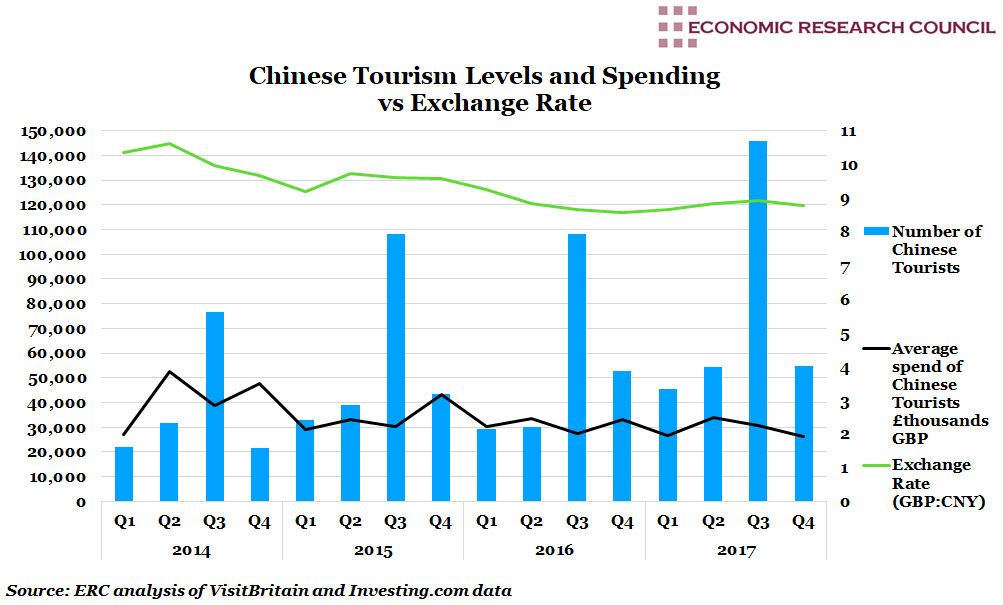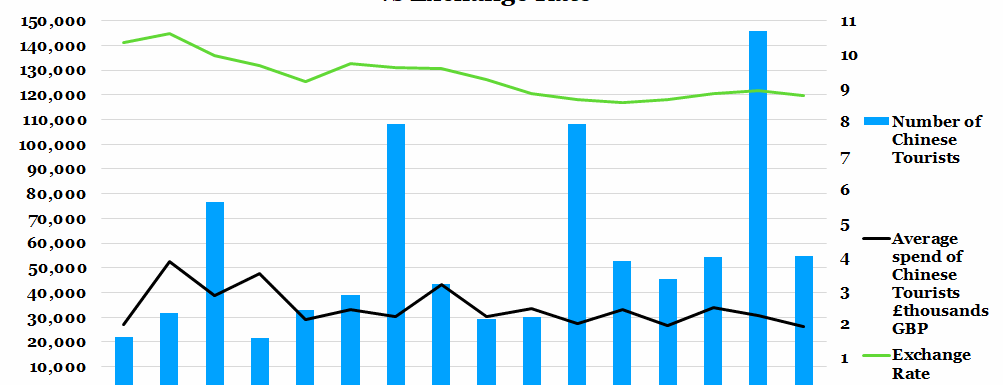
Summary
As the exchange rate between Sterling and Chinese Yuan decreased over the past five years, traveling to the United Kingdom has become more affordable and attractive to Chinese tourists. There is a clear spike during the months from July to September. However, as the number of tourists has clearly risen, their average spend has not followed suit, hovering around £2,000 GBP per tourist. Although there have been some reports of Brexit negatively impacting the number of overseas visitors, Chinese tourism numbers do not appear to be affected as they continue to grow year on year. As average spend reflects the mean, it is likely that the response to the drop in sterling value has been to entice tourists from China in greater numbers, rather than to encourage the same few visitors to spend more. The total number of Chinese tourists has increased every year while the exchange rate decreased overall. Despite rising wealth in China, tourists’ average consumption in 2014 exceeds that in 2017, despite their total number doubling in the same period.
What does the chart show?
The blue bars denote the number of Chinese tourists in each quarter over the years 2014 to 2017, measured against the left hand axis. The presence of a peak season in Q3 is quite pronounced. Chinese tourists here are defined as people entering on tourist visas obtained in China and excludes international students. The black line plots the average spend of individual Chinese tourists in thousands of pounds Sterling. The green line reflects the exchange rate (GBP: CNY). The exchange rate and average spend are measured on the right hand axis.
Why is the chart interesting?
The peak in Q3 is likely a result of Chinese people’s reticence to travel during the most important Chinese festivals taking place early in the year. Lunar New Year is celebrated in January or February with most people engaging in domestic tourism, returning to their hometowns to reunite with their families. During the summer, from June to the beginning of September, many middle schools and high schools in China conduct field trips to the UK, with many parents traveling with their children as well.
One of the most rapid decreases in the exchange rate came in 2014, during the campaigns around Scottish independence and prior to the Brexit referendum. The value of the pound decreased further in 2016 following the referendum, but has now stabilised at approximately 17% lower than five years ago.
The average spend of Chinese tourists has fluctuated and does not correlate with the number of Chinese tourists. The lower average spend likely reflects the increasing number of middle income Chinese people who are now able to travel to the UK at all. The population of middle income in China has been increasing over the last few decades. In 2018, more than 300 million people satisfied the World Bank’s standard for middle income; earning between $10 and $100 per day. To illustrate how stark this growth has been, the same figure in 2016 was just 109 million.
There will likely be a number of phases which will shift the balance in the chart above. Initially, the biggest factor will be the continued increase in the number of visitors; causing the average spend to decrease accounting for the larger number of small children and other low-spending tourists. Chinese tourist consumption will then rise to reflect their increased wealth overall.
UK retailers are paying increasing attention to the needs of Chinese consumers, adjusting both their payment systems as well as product offering to Chinese preferences. An example of a shopping destination that has geared itself towards Chinese consumers is Bicester Outlet Village, which regularly promotes itself in China, employs many mandarin-speaking staff and organises trips for tourists from London. During Lunar New Year 2018, Bicester Village rolled out Chinese payment methods Alipay and WeChat. Data from Alipay showed that the total number of payments made in the UK by Chinese visitors increased 90-fold by October 2018.
Week 7, 2019

